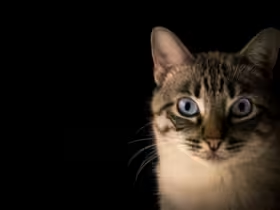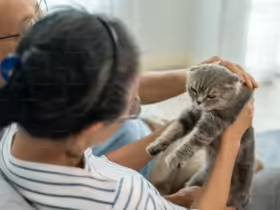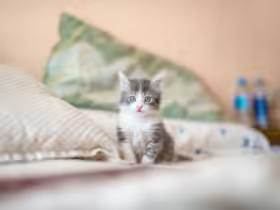Is Your Cat Suffering From Depression? Understanding and Addressing Feline Depression
Cats are known for their independent nature, but they can also experience emotional struggles similar to humans. Depression in cats is a real condition that can affect their well-being and quality of life. Recognizing the signs of feline depression and understanding how to address it is crucial for maintaining your cat’s health and happiness. This comprehensive guide will help you identify symptoms, explore potential causes, and provide strategies for managing and treating depression in your feline friend.
What is Feline Depression?
Feline depression is a state of prolonged sadness or emotional distress that affects a cat’s behavior, appetite, and overall health. Unlike temporary mood changes, depression in cats can last for weeks or even months and may require intervention to resolve.
Recognizing the Signs of Cat Depression
1. Changes in Appetite
- Decreased Appetite: A cat with depression may eat less or refuse food altogether, leading to weight loss and malnutrition.
- Increased Appetite: Some cats may overeat or seek out unusual food sources as a comfort-seeking behavior.
2. Altered Sleep Patterns
- Excessive Sleeping: Cats that sleep more than usual or seem lethargic may be experiencing depression.
- Restlessness: Conversely, some depressed cats may have trouble settling down and may appear restless or agitated.
3. Changes in Grooming Habits
- Over-Grooming: Excessive grooming can be a sign of stress or depression, leading to bald patches or skin irritation.
- Under-Grooming: A lack of grooming can result in a matted coat, poor hygiene, and a generally unkempt appearance.
4. Behavioral Changes
- Withdrawal: Depressed cats may hide more frequently or avoid interaction with their human family members and other pets.
- Aggression or Irritability: Some cats may become more aggressive or irritable, displaying behavior that is out of character for them.
5. Decreased Activity Levels
- Lack of Play: A cat that used to be playful but now shows little interest in toys or games may be feeling depressed.
- Reduced Exploration: Depressed cats may spend more time lying around and show less curiosity about their environment.
6. Unusual Vocalization
- Increased Meowing: Some cats may vocalize more frequently as a way to express discomfort or seek attention.
- Decreased Vocalization: Conversely, a normally vocal cat that suddenly becomes quiet may be experiencing depression.
7. Physical Symptoms
- Changes in Bathroom Habits: Depression can sometimes lead to changes in litter box habits, such as urinating or defecating outside the box.
- Weight Changes: Significant weight loss or gain can accompany depression and may indicate a need for further evaluation.
Common Causes of Feline Depression
1. Environmental Changes
- Moving to a New Home: Relocating can be stressful for cats and may lead to temporary or prolonged depression.
- Changes in Household Dynamics: The introduction of new pets, the absence of a family member, or changes in routine can impact your cat’s emotional state.
2. Loss or Grief
- Loss of a Companion: The death of another pet or human family member can lead to grief and depression in cats.
- Separation Anxiety: Cats may experience depression when separated from their favorite people or other pets.
3. Health Issues
- Chronic Illness: Ongoing health problems, such as kidney disease or arthritis, can contribute to depression and affect your cat’s mood.
- Pain or Discomfort: Unaddressed pain from an injury or illness can lead to behavioral changes and depression.
4. Lack of Stimulation
- Boredom: Cats that lack environmental enrichment, such as toys or interactive playtime, may become bored and depressed.
- Limited Social Interaction: Insufficient social interaction and bonding time with their human family members can impact a cat’s emotional well-being.
5. Stress and Anxiety
- Loud Noises: Frequent loud noises, such as construction or fireworks, can stress cats and lead to behavioral changes.
- Conflicts with Other Pets: Tensions or conflicts with other animals in the household can create a stressful environment for your cat.
Diagnosing Depression in Cats
1. Veterinary Examination
- Physical Exam: A thorough veterinary examination is essential to rule out underlying medical conditions that may be contributing to your cat’s symptoms.
- Behavioral Assessment: Your veterinarian will assess your cat’s behavior and may ask questions about recent changes in their environment or routine.
2. Diagnostic Tests
- Blood Work: Blood tests can help identify underlying health issues, such as thyroid problems or infections, that may be contributing to your cat’s depression.
- Urinalysis: Testing urine can provide additional information about your cat’s overall health and detect potential issues affecting their mood.
3. Behavioral Evaluation
- Observation: Monitoring your cat’s behavior and noting any significant changes or patterns can provide valuable insights into their emotional state.
- Environmental Assessment: Assessing changes in your cat’s environment or routine can help identify potential stressors or triggers for depression.
Treating and Managing Cat Depression
1. Addressing Underlying Health Issues
- Medical Treatment: If an underlying health condition is identified, treating that condition may help alleviate symptoms of depression.
- Pain Management: Providing pain relief for any chronic or acute discomfort can improve your cat’s quality of life and mood.
2. Enhancing the Environment
- Enrichment: Provide a variety of toys, scratching posts, and interactive play to keep your cat mentally and physically stimulated.
- Safe Spaces: Create cozy, safe spaces where your cat can retreat and feel secure.
3. Increasing Social Interaction
- Quality Time: Spend quality time with your cat through gentle petting, playtime, and positive interactions to strengthen your bond and provide emotional support.
- Companionship: If appropriate, consider introducing another pet or providing additional companionship to help alleviate loneliness.
4. Maintaining a Consistent Routine
- Stable Routine: Maintain a consistent daily routine to provide a sense of stability and predictability for your cat.
- Feeding Schedule: Stick to regular feeding times and provide a balanced diet to support overall health and well-being.
5. Reducing Stress
- Minimize Disruptions: Avoid sudden changes in your cat’s environment or routine and minimize exposure to stressful situations.
- Calming Products: Consider using calming products, such as pheromone diffusers or calming treats, to help reduce anxiety and promote relaxation.
6. Professional Help
- Behavioral Therapy: In some cases, consulting with a veterinary behaviorist or animal psychologist may be beneficial in addressing behavioral issues and developing a tailored treatment plan.
- Support Groups: Online or local support groups for pet owners can provide additional resources and advice for managing feline depression.
Preventing Depression in Cats
1. Regular Veterinary Check-Ups
- Health Monitoring: Schedule regular veterinary visits to monitor your cat’s overall health and address any emerging issues early.
2. Environmental Enrichment
- Interactive Play: Provide a variety of stimulating toys and activities to keep your cat engaged and entertained.
- Comfortable Environment: Create a comfortable and safe living space that meets your cat’s physical and emotional needs.
3. Social Interaction
- Positive Interactions: Ensure your cat receives plenty of positive interactions and attention from their human family members.
4. Addressing Changes
- Gradual Adjustments: Introduce changes to your cat’s environment or routine gradually to minimize stress and allow time for adjustment.











Leave a Reply